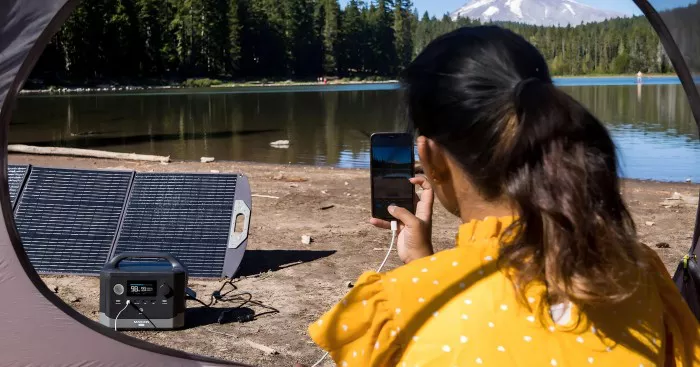Generators and solar power are typically considered separate solutions for energy needs. Generators usually run on fossil fuels like diesel or gasoline, while solar power harnesses sunlight to generate electricity. However, it is possible to integrate solar power with generator systems to create a hybrid setup. This guide explores how solar power can interact with generator systems, including the feasibility, benefits, and implementation of such a setup.
1. Understanding Solar-Powered Generators
1.1 What is a Solar-Powered Generator?
A solar-powered generator is a system that combines solar panels, a battery storage system, and an inverter to provide electricity from solar energy. Unlike traditional generators that rely on fuel, these systems generate and store power from sunlight. Solar-powered generators are designed for various applications, including backup power, off-grid living, and emergency situations.
1.2 Key Components
The primary components of a solar-powered generator include solar panels, which capture sunlight and convert it into direct current (DC) electricity; a battery storage system, which stores the generated electricity for later use; and an inverter, which converts DC power into alternating current (AC) suitable for household appliances.
2. Integrating Solar Power with Traditional Generators
2.1 Hybrid Systems
Hybrid systems combine solar power with traditional generators to create a versatile energy solution. In such systems, solar panels generate electricity, which is stored in batteries and used to power devices. When solar power is insufficient or unavailable, the traditional generator can provide additional power to ensure a continuous supply.
2.2 How It Works
Solar Panels: Solar panels capture sunlight and convert it into electricity. This electricity is directed to a battery storage system.
Battery Storage: The batteries store the solar energy for use when sunlight is not available, such as during the night or cloudy days.
Inverter: The inverter converts the stored DC power from the batteries into AC power for use with household appliances.
Generator: When solar power is not sufficient, the generator kicks in to provide additional power. The generator can be manually or automatically activated based on the system’s configuration.
3. Benefits of Combining Solar Power with Generators
3.1 Reduced Fuel Dependence
Integrating solar power with a traditional generator reduces the need for fossil fuels. The solar panels provide a renewable energy source, decreasing the reliance on diesel or gasoline.
3.2 Lower Operating Costs
By utilizing solar power, you can reduce the amount of fuel needed for the generator. This can result in lower operating costs and reduced maintenance requirements for the generator.
3.3 Environmental Impact
Solar power is a clean, renewable energy source. Combining it with a generator reduces the overall environmental impact by decreasing the emissions associated with fuel combustion.
3.4 Increased Reliability
A hybrid system increases energy reliability. Solar power can handle routine energy needs, while the generator provides backup power during periods of high demand or when solar energy is insufficient.
4. Implementation Considerations
4.1 System Design
Designing a hybrid system requires careful planning. Determine the power requirements of your household and match them with the capacity of the solar panels, battery storage, and generator. Ensure that the generator can complement the solar power system effectively.
4.2 Battery Storage
The capacity of the battery storage system is crucial for managing energy. Choose batteries that can store enough power to meet your needs during periods when solar energy is not available.
4.3 Inverter Compatibility
Ensure that the inverter is compatible with both the solar power system and the generator. The inverter must handle the combined power output from the solar panels and the generator.
4.4 System Maintenance
Regular maintenance is essential for both solar panels and generators. Keep the solar panels clean and inspect the generator periodically to ensure reliable operation.
see also: 5 Best Portable Solar Generators for RVs
5. Limitations and Challenges
5.1 Initial Costs
The initial cost of installing a hybrid system can be high. This includes the cost of solar panels, battery storage, and the generator itself. However, the long-term savings on fuel and maintenance may offset these costs.
5.2 Space Requirements
Solar panels require adequate space for installation. Ensure that you have sufficient space to mount the panels where they can receive optimal sunlight.
5.3 Energy Management
Effective energy management is crucial for a hybrid system. Ensure that the system is well-calibrated to switch between solar power and generator power seamlessly.
Conclusion
While a generator cannot run solely on solar power, integrating solar panels with a traditional generator can create an efficient and eco-friendly hybrid system. By combining the renewable energy of solar power with the reliability of a generator, you can reduce fuel dependence, lower operating costs, and minimize environmental impact. Careful planning and proper maintenance are essential to maximizing the benefits of such a system. With the right setup, a hybrid solution can provide a reliable and sustainable energy source for various applications.
Related topics:
- Why Blueti is the leading manufacturer of solar generators?
- TOP 5 Rated Portable Solar Generators: Best Options for Versatile Power Solutions
- Is It Worth Buying a Portable Solar Generator?

